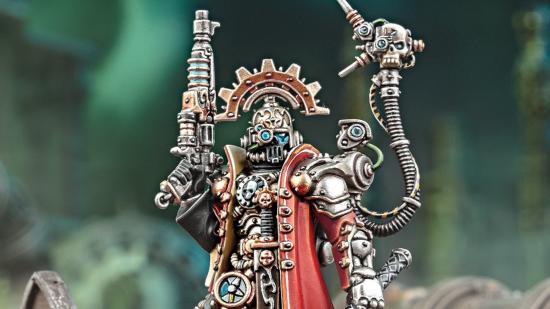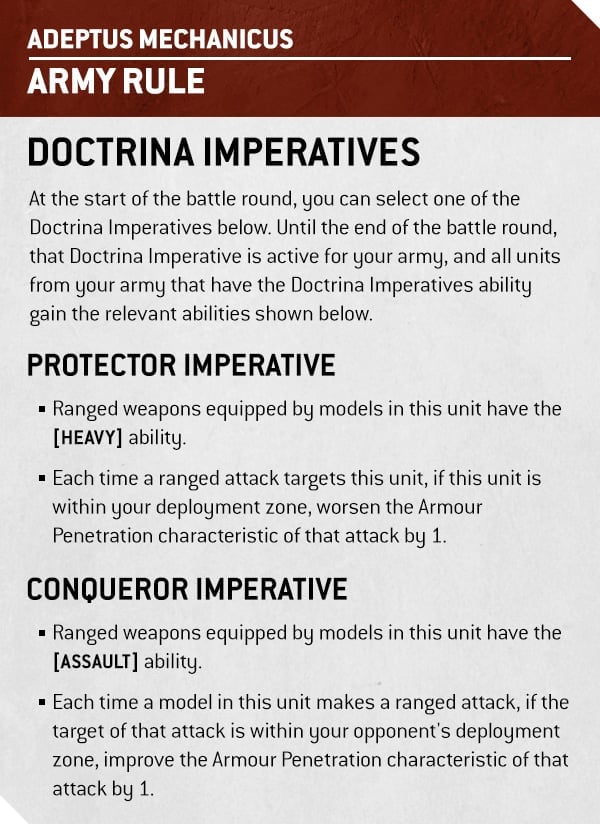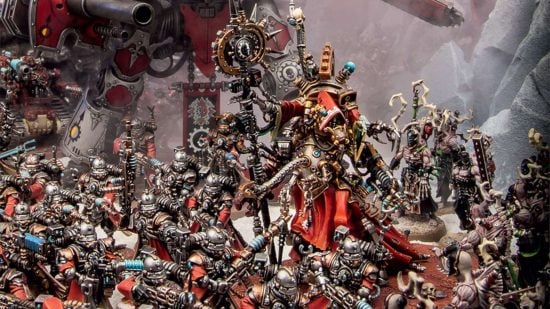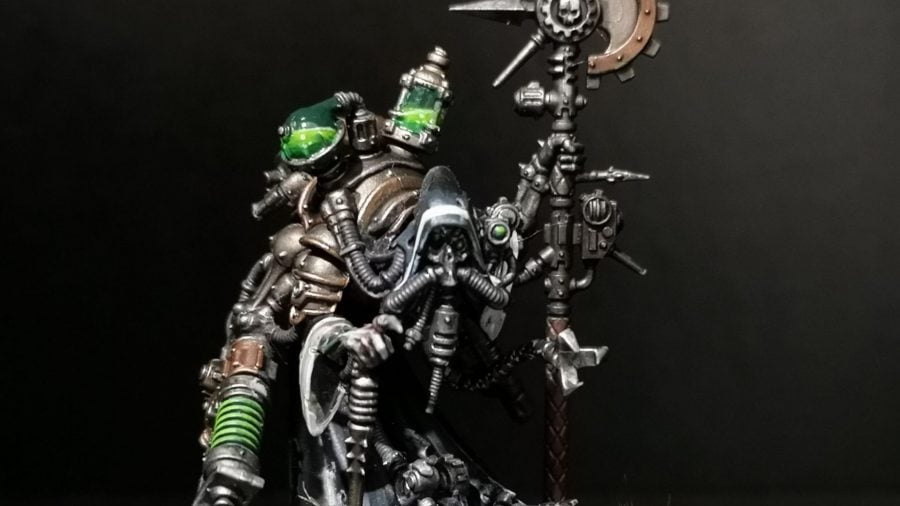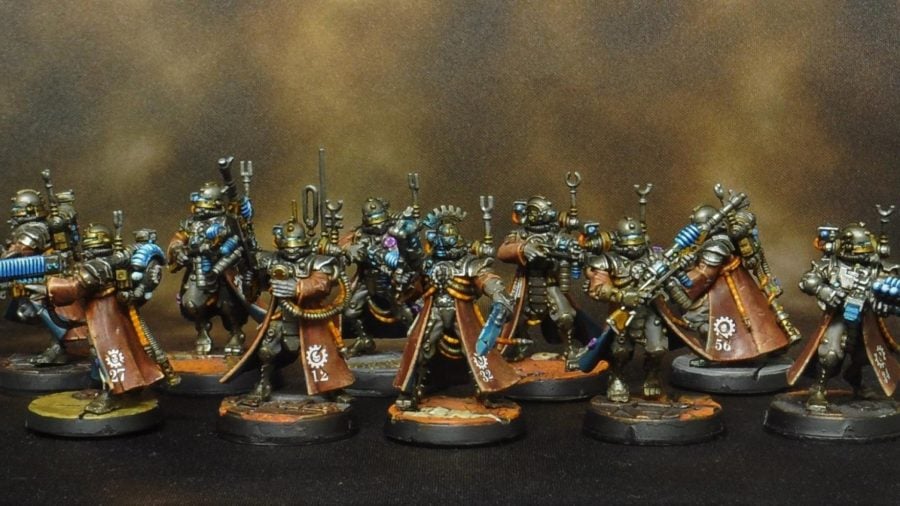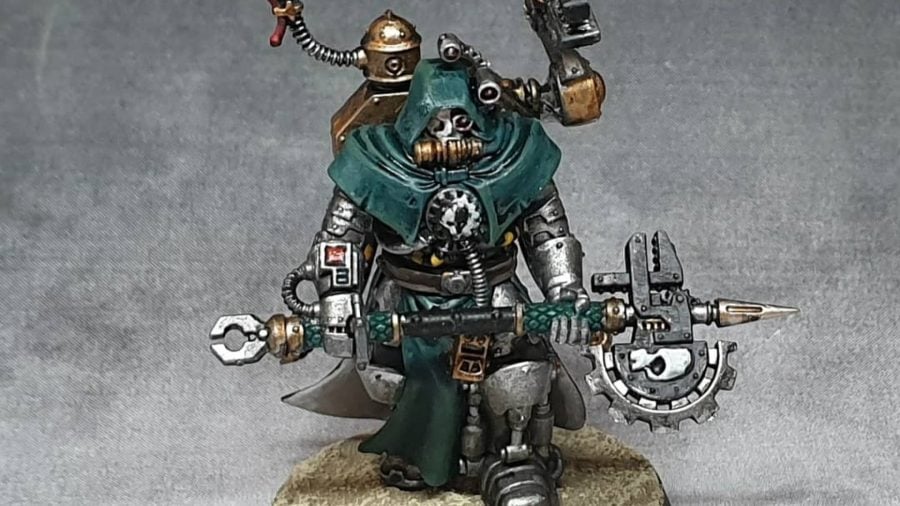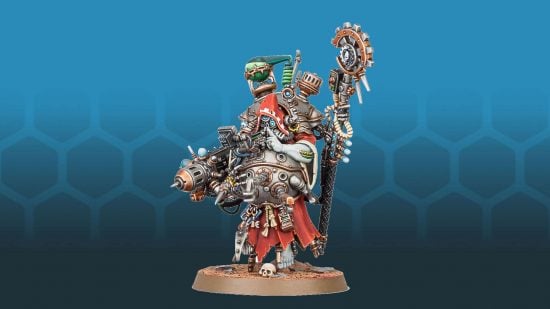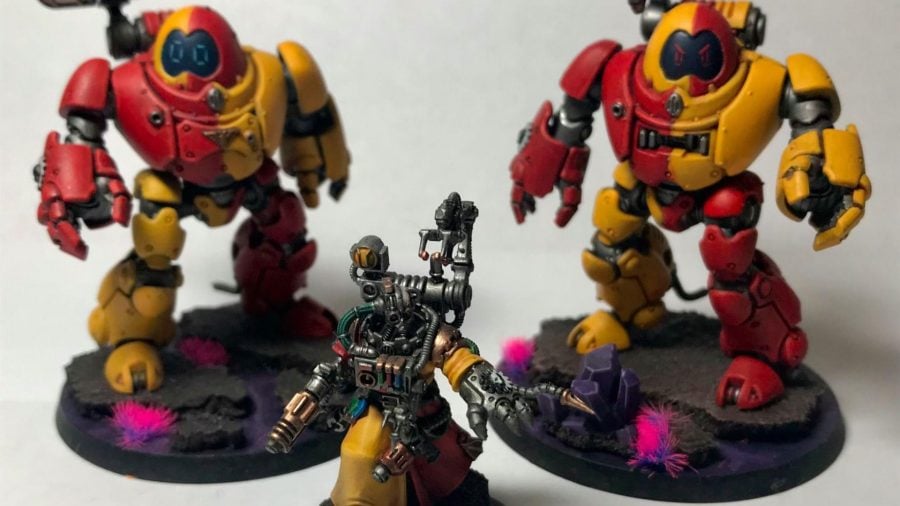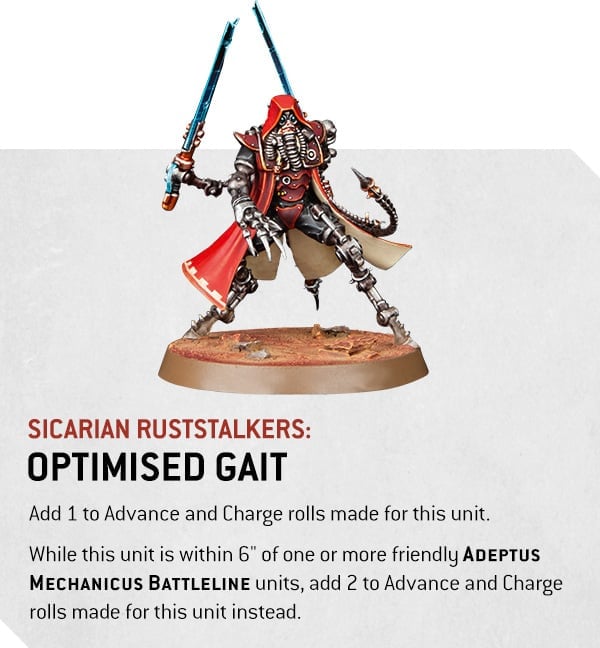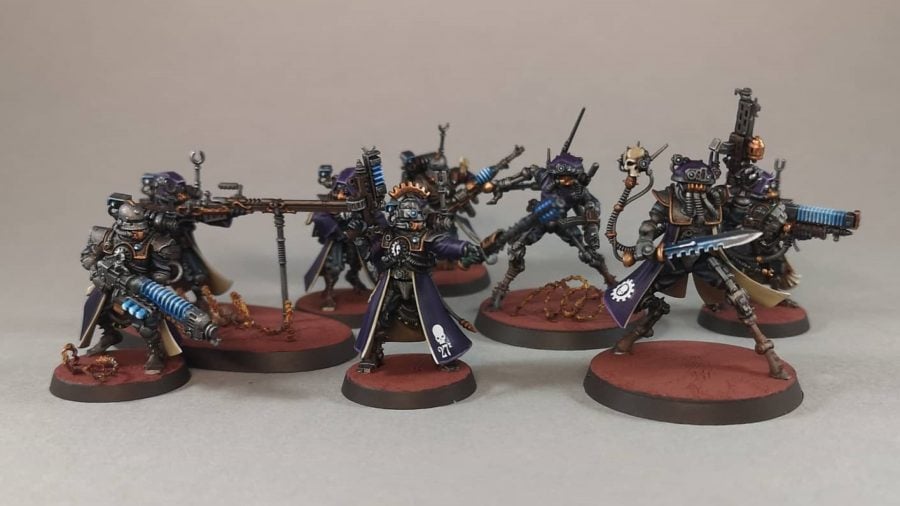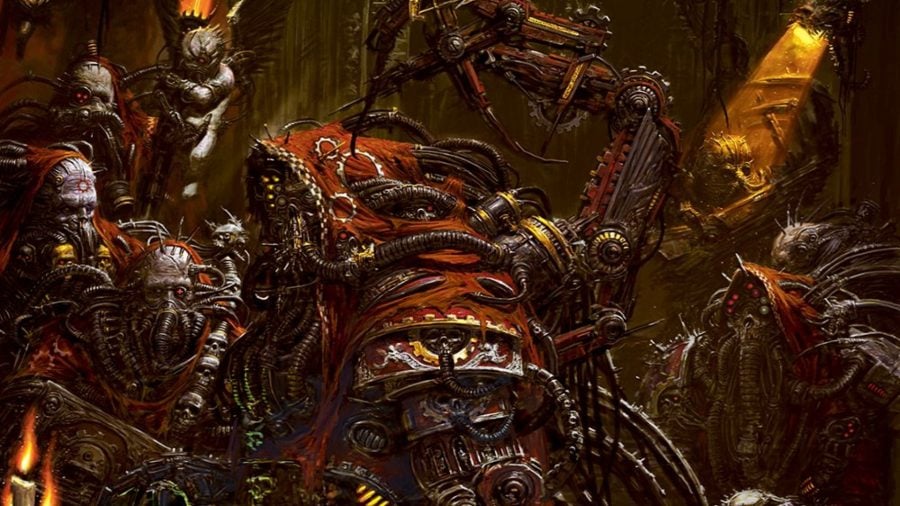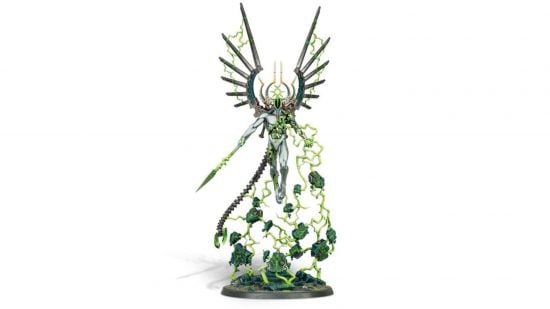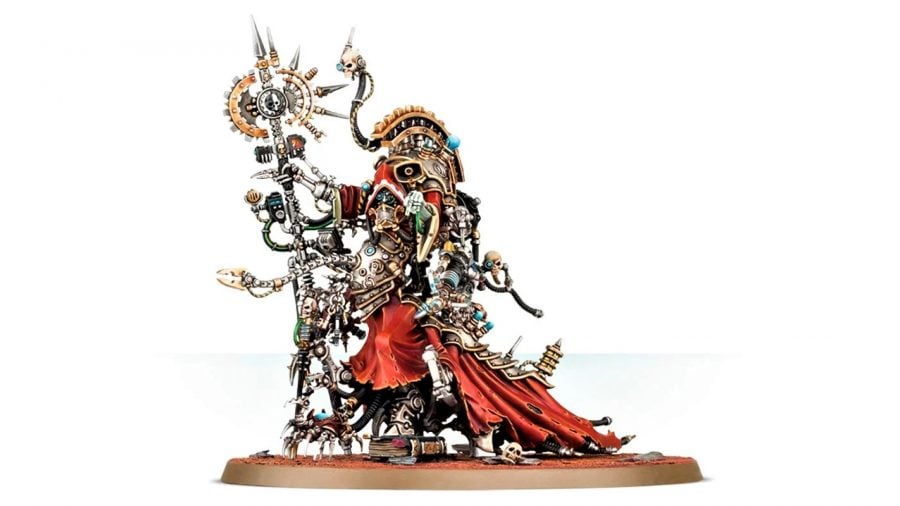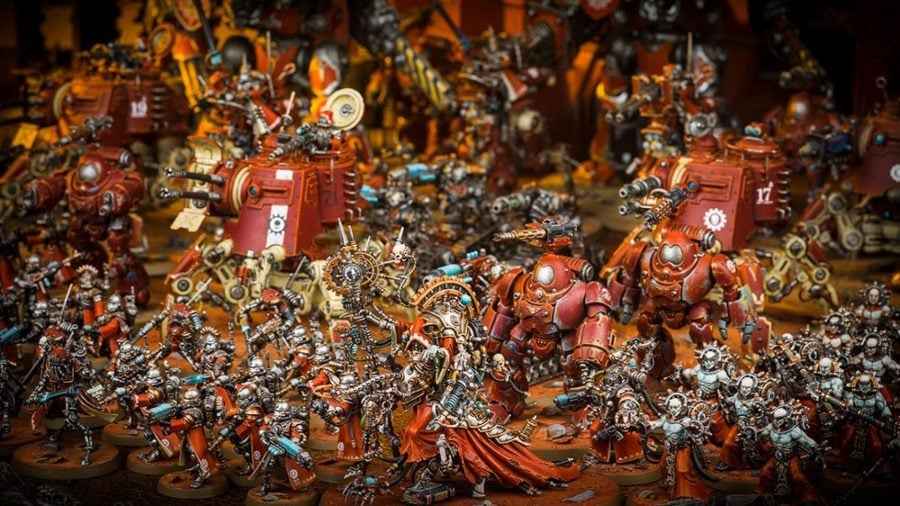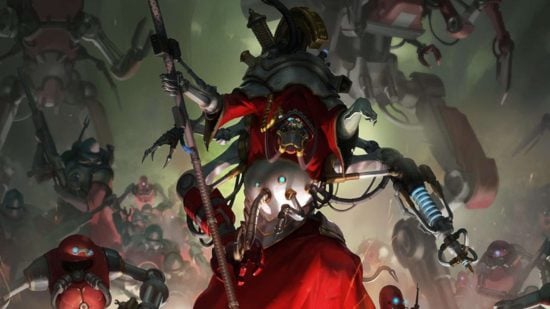The Warhammer 40k Adeptus Mechanicus faction might be the most inhuman, contradictory offshoot of the human species in the Dark Millennium. It is a religious cult devoted to technology, both superstitious of science and yet utterly avaricious in the pursuit of knowledge. This guide introduces the Adeptus Mechanicus lore, their key rules in Warhammer 40k 10th edition, and their genius figurehead Belisarius Cawl.
If you want an imposing, flexible, and customisable army that packs serious firepower, look no further than the Adeptus Mechanicus. If you’d prefer something simpler, check out our list of the other Warhammer 40k factions, or our info on the Imperium of Man – a lot of the Warhammer 40k 10th edition army rules are still free, and you can check out a lot of factions without spending a nickel.
The Adeptus Mechanicus are substantially simplified in 10th edition compared to ninth edition – no bad things, as the faction had one of the most bewilderingly complex Warhammer 40k Codex army books in ninth edition.
Here’s what you need to know about the Adeptus Mechanicus:
- Adeptus Mechanicus 10th edition army rules
- Adeptus Mechanicus 10th edition detachments
- Adeptus Mechanicus battleline
- Adeptus Mechanicus lore
- The Dragon of Mars
- Adeptus Mechanicus characters – Belisarius Cawl
Adeptus Mechanicus 10th edition army rules
The main Adeptus Mechanicus 10th edition army rules are the Doctrina Imperatives, which most of your units have access to; the exception being the Kastelan Robots, which are too slow to compute something as fast moving as a change in combat doctrine.
At the start of the Battle Round you’ll get to pick a Doctrine: the Protector Imperative grants units the Heavy Weapon Ability and an armor buff in your deployment zone; while the Conqueror Imperative grants the Assault Weapon Ability, plus additional AP when targeting units in the opponent’s deployment zone.
Doctrina Imperatives existed in ninth edition, but only applied to Skitarii units, and came with a penalty as well as a buff. The new ability helps everyone equally.
Adeptus Mechanicus 10th edition Detachments
With a full Codex army book, the Adeptus Mechanicus faction has access to five Warhammer 40k detachments. Each grants them access to a different army-wide special rule, 40k stratagems, and enhancements.
Adeptus Mechanicus Rad-Zone Corps Detachment
The Adeptus Mechanicus Rad-Zone Corps Detachment is an updated version of the Rad-Cohort Detachment from the Ad-Mech Index. It has a wonderfully grimdark narrative: at the start of the battle, you bombard your opponent’s deployment zone with radioactive warheads.
At the start of the battle, your opponent must choose whether each of their units risks suffering D3 mortal wounds on 3+, or else become Battle-Shocked for the entire Battle Round and take the mortal wounds on a 5+. From the second turn onwards, enemy units that remain in their irradiated deployment zone risk suffering an additional mortal wound on a 3+, and the unit needs to take a Battle Shock test.
This isn’t the most powerful Detachment ability; if your opponent needs to use a particular Stratagem in the first turn, they’ll accept the greater risk of taking mortal wounds. The Dark Angels Unforgiven Task Force actually gets more powerful when its units are Battle-shocked.
However, putting enemy units at risk of Battle-shock throughout the game, and therefore shutting down many Stratagems, could restrict their options in a clutch moment. It’s also a way to punish static gunline armies. If that chimes with your way of doing battle, you can buy the Radial Suffusion enhancement, and extend the aura of radiation poisoning out to 6″ beyond you opponent’s deployment zone.
The Warhammer 40k Stratagems for the Rad-Zone Corps emphasize the synergy between Skitarii battleline units and other Skitarii troops. The Baleful Halo and Bulwark Imperative both provide defences against enemy attacks, while Aggressor Imperative allows swift movement, and Pre-Calibrated Purge Solution grants a shooting buff into the enemy deployment zone.
For each of these, if you target a Battleline unit with the stratagem, you can also apply the buff to a friendly non-battleline Skitarii within 6″.
Adeptus Mechanicus Skitarii Hunter Cohort Detachment
The Skitarii Hunter Cohort detachment is – as the name suggests – all about Skitarii, particularly the non-vehicle Skitarii units. Anything smaller than an APC benefits from the Stealth ability, and Sicarian units – the elite stealth infiltrators – have the Benefit of Cover against ranged attacks made from beyond 12″.
This detachment’s enhancements can only be equipped to Skitarii characters, and focus on letting you maneuver – whether that’s granting a unit the Infiltrators and Scouts 6″ abilities, or allowing the bearer’s unit to reposition after shooting.
Adeptus Mechanicus Data-Psalm Conclave Detachment
The Data-Psalm conclave is focused on the tech priesthood and their personal servitors, Tech priest characters, Electro-priest units, and Kataphron servitors improved armor penetration against targets within half range, and additional Strength and Attacks in melee on the turn that they make a charge move.
It’s a simple force multiplier for a fairly limited set of units, something that carries through to the Stratagems, all of which can only effect Cult Mechanicus units. The Chant of the Remorseless Fist improves a unit’s melee attacks; the Luminescent Blessing grants a unit a 4+ invulnerable save against shooting; the Litany of the Electomancer simply electrocutes enemies standing too close to your units.
Adeptus Mechanicus Explorator Maniple Detachment
The Explorator Maniple detachment reflects the Mechanicus’ relentless pursuit of lost knowledge; it’s focused on transport units and objective markers. It has a very simple army ability: each turn, you’ll select an ‘Acquisition’ objective marker to fixate on. Any of your units that are within range of the marker, or targeting an enemy within range of the marker, can re-roll Wound rolls of one.
The enhancements for this detachment all grant buffs relating to that Acquisition marker, which could be a 4+ invulnerable save for their whole unit while within range, or +1 to Hit enemy units standing close to the marker. This is a detachment for players who enjoy playing the objective game as much as they enjoy killing their opponent’s units.
Adeptus Mechanicus Cohort Cybernetica Detachment
The Cohort Cybernetica extends the army’s Doctrina Imperatives special rule to Legio Cybernetica units, making it by far the simplest of the Detachments. The Enhancements provide some interesting buffs for vehicles as well, such as the Necromechanic ability that reduces all damage from an enemy attack against a robot or vehicle to zero; or Emotionless Clarity, which ensures bots and vehicles explore when they’re destroyed.
There are some powerful buffs in this detachment’s Stratagems. Machine Spirit Resurgent grants a unit that is below starting strength – which for a vehicle, means it has suffered a single wound – to re-roll Hit rolls for a Battle Round; if the unit is below Half-Strength, you get to re-roll to wound as well. Similarly, Auto-Divinatory Targeting boosts the Ballistic Skill of a vehicle or robot unit to 3+ when targeting enemies near a selected objective maker, as well as allowing them to ignore cover.
Adeptus Mechanicus battleline
Part of the Adeptus Mechanicus’ complexity has always come from the many buffs and synergies between its units. While this has traditionally been the result of tech-priests tinkering with their servants’ programming, in 10th edition battleline units, such as the Skitarii Rangers and Skitarii Vanguard, activate additional abilities for their fellow servants of the machine god.
For example the Sicaran Ruststalkers get +1 to Advance and Charge rolls, which increases to a +2 bonus when they’re within 6” of a Battleline unit.
The Skitarii Vanguard’s Rad-saturation aura is a potent tool for controlling objectives: while within 3” of the Vanguard, non-vehicle enemy units suffer -1 to their objective control value. Space Marine terminators can’t contest objectives with radiation poisoning.
Adeptus Mechanicus lore
What can the Adeptus Mechanicus lore tell us about these confounding, chrome-limbed enigmas? Though the AdMech prize logic and calculation, and deride emotion, they are driven by a fanatical devotion to the cult of the Machine God.
They are the custodians of mankind’s technology and knowledge, yet these invaluable secrets are cloaked in ritual and mystery. They abhor the alien for its deviance from the holy human form, but spend their unnaturally extended lives purging their bodies of weak flesh and replacing it with cold metal.
The Adeptus Mechanicus predates the Imperium of Man. Though holy Mars was terraformed in ages long past, the planet was consumed by industry, choked beneath the radiation and waste of a million forges, and the aftermath of ancient wars.
During the long Age of Strife, when the first human galactic civilisation was torn apart by Warp storms and preyed upon by alien and daemonic horrors, on the red planet, technology meant life. Soon a cult of machine worship took hold. Mars was the first Forge World, and its fabricator-kings became the Mechanicum.
Throughout that long night, Mars sent out explorator fleets in a blind attempt to regain contact with lost human colonies and build new dominions. A precious few of these would survive, seeding new Forge Worlds in the image of Mars – each of which would go on to develop their own cultures and variants on the Martian Creed.
When the Emperor first conquered Terra and initiated the Great Crusade, Mars was brought into the Imperium as a vassal state. In exchange for providing the ships, arms, and armor needed by the great warhosts of the Imperial Army and Legiones Astartes, Mars was offered control of the human technology it recovered.
This alliance was shattered during the Horus Heresy, as half of the Mechanicum was lured to the cause of the traitors by Chaos’ promises of forbidden, arcane technology. During this great cataclysm, treasure troves of knowledge and artifice were lost, annihilated in the fires of treachery, and even Mars itself became a boiling cauldron of internecine strife.
During the Heresy, the loyal elements of the Mechanicum reformed into the Adeptus Mechanicus. Though they are bonded closely to the Imperium of Man, and their highest official, the Fabricator General of Mars, holds a permanent position as one of the twelve High Lords of the Imperium, they are still a culture apart.
Their devotion to the Emperor is in his aspect as the Omnissiah, corporeal embodiment of the Machine God. Their commitment to the wars of man is for the preservation and recovery of ancient technology, not the defence of human lives.
Indeed, the Adeptus Mechanicus have a callous disregard for human life, but a holy reverence for the machine. For them, all technology is an expression of the will and eminence of the Machine God, and the operation of everything, from physics to biology, is an expression of His divine Motive Force.
They see themselves as advancing a great work, bringing about a perfect mechanical creation. It does not matter to them how many billions of humans die in service to that vision.
The Dragon of Mars
The Dragon of Mars is one of the deepest secrets, unknown even to many of those at the heart of the Cult Mechanicum. The main account of this arcane entity can be found in Mechanicum, the ninth Horus Heresy book.
The Dragon of Mars is imprisoned within the Noctis Labyrinth, a bewildering maze of subterranean catacombs buried within Mars. It is profoundly attuned to mechanical processes, exuding an aura of fascination with all things scientific and deterministic, and it is possible that it is this influence which caused the religious veneration of technology to dominate the red planet.
The Dragon was banished to Mars by the Emperor of Mankind in some long ago age; the conflict between the Emperor and this being may even have been the origin of dragon-slaying myths such as Beowulf and St. George. Its imprisonment on Mars suited the Emperor, who predicted its role creating a technocracy that he could bend to his will within the solar system.
The exact nature of the Dragon of Mars is not known explicitly, but it’s likely that it is a shard of a C’tan, the ancient void gods that transformed the Necrontyr race into the undying Necrons close to the dawn of time.
Adeptus Mechanicus characters – Belisarius Cawl
There’s only one Adeptus Mechanicus special character model, but he casts a long shadow – and not just because his body is a cybernetic centipede over 10 feet tall.
No Tech-Priest, save perhaps the Fabricator General of Mars, has put their maker’s mark on Warhammer 40k’s current narrative cycle – the Era Indomitus – as firmly as Belisarius Cawl.
Long ago, in the wake of the Horus Heresy, the Imperial Regent Roboute Guilliman tasked Cawl with a project of dread importance. For the next ten millennia, Cawl worked in secret, using genetic lore from the Emperor’s Primarch project and his own techno-archaeological discoveries, in order to found the mighty warhost of the Primaris Space Marines.
Only with the resurrection of Guilliman, and the coming of the Great Rift, has Cawl finally unleashed these upgraded warriors in aid of the Imperium. In short: all the shiny new Space Marine vehicles and weaponry that have been released since eighth edition dropped in 2017 are the product of Belisarius Cawl’s mad genius.
Cawl has changed a lot in the 10,000 or more years of his life, literally losing his mind (or at least some of his ancillary data-stacks) several times, but he’s always been arrogant – and borderline heretical – in his willingness to experiment with holy technology.
You can learn more about him as a young man in Wolfsbane, Horus Heresy book 49, or his exploits in the Era Indomitus in The Great Work. You’ve got to admire his confidence: The Great Work involves a heist on a Necron tomb complex, right under the noses of a Genestealer infestation. He’s certainly got big ball bearings.
Belisarius Cawl is an Epic Hero and something of a beast on the tabletop. Armed to the teeth with the finest guns and weapons available to the forges of Mars, such as the Solar Atomiser (18” range, D3 shots, S14, AP -4, Damage 3 with the Melta D3 and Blast abilities), he also packs a suite of command abilities.
Each round, Canticles of the Omnissiah allows him to pick one of three aura abilities, granting Adeptus Mechanicus units within 6″ rerolls on to-hit rolls of one, bonuses on Battle-shock or Leadership tests, or the Benefit of Cover against ranged attacks.
With thanks to Mel Bushell for her fantastic dark-robed Dominus, Nerodine for his gorgeous Vanguard unit, Heather’s fetching dark jet tech-priest, JB for his impressive quartered red and yellow robots, and Pandaemonium Miniatures Paul’s sinister purple Skitarii.
